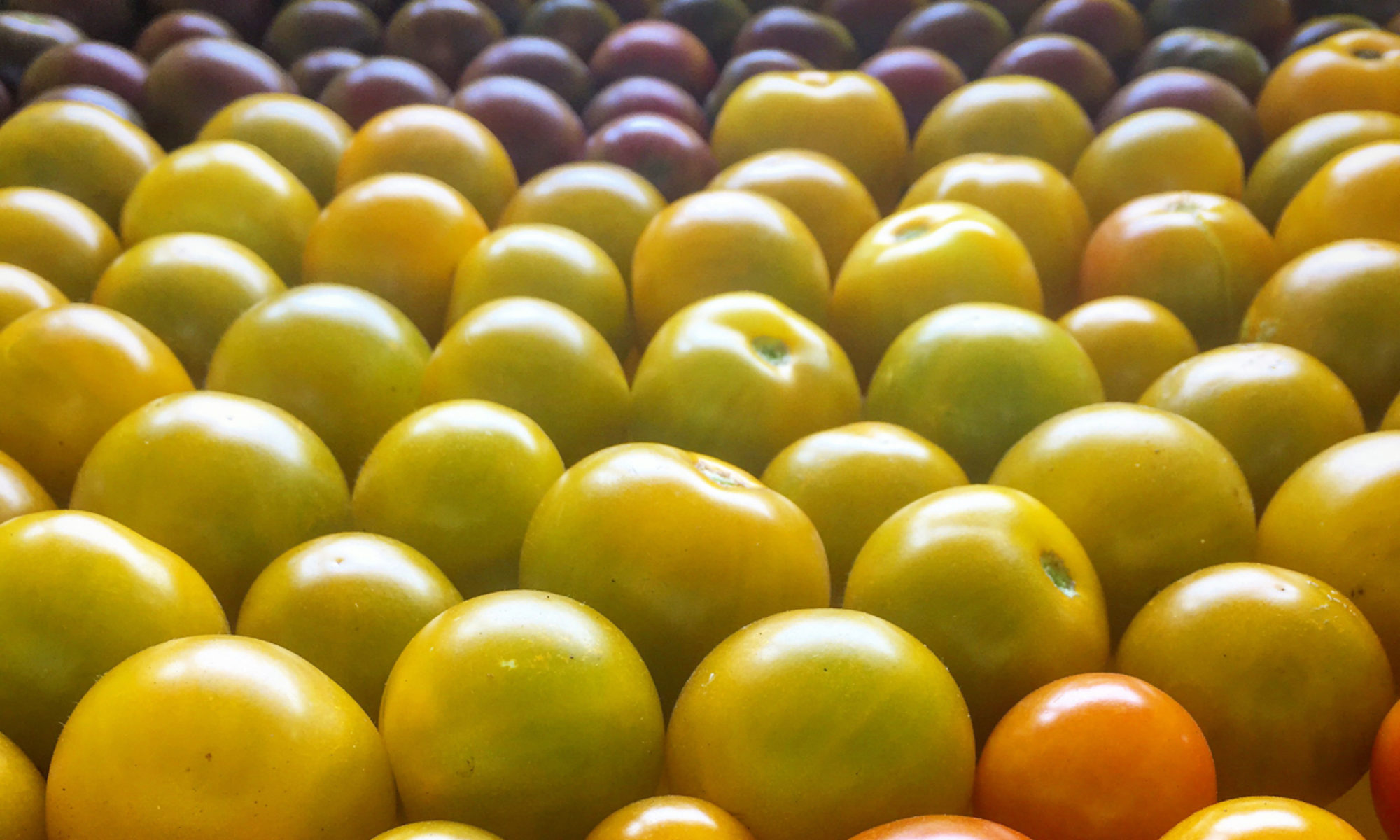
The other day I sat down with Louis at Our Table Coop to outline a cover cropping plan for the summer. For the past 15 years I’ve been using two basic cover crops here in the Northwest for filling in summer gaps in the field: buckwheat and sudan grass. I’ve experimented with a few others and I’m continuing to experiment, but those two are solid and each has a particular place. Creating the summer cover crop plan is pretty simple using those two crops, once the crop plan is mapped out, which I usually have done in December or Januay. The whole process of figuring out what beds would get buckwheat and which would get sudan, and how much of each we needed to order was done in about a half hour. Here’s are the basics of my approach.
Buckwheat gets planted anywhere there’s at least an eight week gap between crops starting in May. Sudan gets planted anywhere there’s more than a ten to twelve week gap starting in May. Gaps are easy to see on the map, they show up as white blocks and you just have to count the number of blocks between the last planned crop (or the expected maturity of a winter cover crop, usually mid-May to early June, and a late planted crop).

I have these kinds of gaps for several reasons and in other parts of the country they might not be as common. We’re typically cropping nearly all of our ground at least once, if not twice a year. Even then we can have blank gaps because our planting season is so long, starting in February and going until October in the field. Some of our cash crops are finished as soon as early April so there’s plenty of opportunity to build soil biology and organic matter and to keep nutrients cycling high in the soil profile by using cover crops in the summer.
A Few Details
Buckwheat takes between four and six weeks to start flowering and it starts setting seed shortly after it starts flowering, within a couple of weeks. The flowers are obvious and white so it’s kind of like a flag saying, “turn me in, now!” It goes faster with longer, warmer days and slower earlier and later. In either case it’s not going to last much longer than six weeks at the outside, and with four weeks, even if it isn’t flowering yet it will already have decent growth in most cases. I like to give a cover crop four weeks to break down before planting, therefore the minimum of an 8 week gap. If it’s less than 8 weeks, I’ll usually just let the weeds go for less picky crops, like tomatoes, or do a bare fallow for trash sensitive crops like carrots or salad greens.

That four to six weeks to flower is about as fast as any weed, but weeds aren’t as kind as the buckwheat and they don’t signal that they need to be mowed before they set seed in the same way. This is one of the reasons I like the buckwheat. Even if the patch is very weedy, those flowers give me a visual signal that I need to mow and incorporate or I’ll have seed setting, buckwheat and weeds.
I usually use a seeding rate of about 60-80 lbs per acre and I either broadcast it with a “belly grinder” (shoulder bag type broadcast spreader), or put it down with a drop spreader. It needs to be incorporated and a ring roller works well, or a shallow disking, or slowly dragging the rototiller over the bed with the pto off. I don’t worry about letting the previous crop break down much after incorporation before seeding, although it’s nice if it can be a week or two after the inital incorporation.
I’ve used all sorts of sudan grass and I’m not particular but I prefer the smaller stemmed types like Piper. In the past it’s been important to specify untreated seed as the seed is commonly treated with fungicide, at least in our area. I have an impossible time finding Organic buckwheat or sudan seed, which makes me think I should start growing it myself. Immediately after that thought I start thinking there must be some reason no one is growing it organically for seed on a small scale and that I’d probably find out why if I tried to.
The sudan starts out a little more slowly than the buckwheat, but it can be maintained essentially indefinitely with mowing, at least until first frost when it will die. I use the same seeding technique as with buckwheat, and go a little heavier, maybe 80-100 lbs per acre. It varies quite a bit how long it takes, but whenever the suday starts to elongate, as if it’s about to send up seed heads, I mow it short. This is usually timed pretty well to knock back any weeds starting to set seed as well. It’s possible to keep mowing it weekly and to maintain a sod, I’ve done it to create alleys in summer squash and melon plantings, mowing regularly with a flail mower, but if I’m just using it as a cover crop I’ll let it go until it is about to head out again before mowing it a second time.

Even though we don’t get any rain in the summer I only ever irrigate these cover crops once, giving them a little over an inch immediately after seeding. There is no question I’d get more biomass if I irrigated more. Whenever the crop is on the edge of a sprinkler irrigated crop and it gets over spray it gets significantly larger. To me, it’s not worth the extra work, or the extra electricity and displacement of limited water resources to get the extra biomass, and I still get good growth and coverage. I do water again after incorporation (or just before if it’s too dry to work in, which is usually not the case as the plants seem to keep the water pumped up into the upper levels of the soil). I water after incorporation to help it break down and to germinate any weed seed that is near the surface during the four week wait before planting a cash crop.

How to Complicate Matters
I really like grass/legume mixes, as the grass and legume are complementary. The grass is good at taking up soil nitrogen, which encourages the legume to work with rizobacteria to fix more nitrogen from the air. The two nurse each other, and the upright structure of the grass provides a scaffold that helps any legume to climb and make more bio-mass without shading itself out.
The legume I’ve had the most success with in Sudan is clover. There are two ways I plant clover with sudan. I have had some success seeding it at the same time as the sudan, although I usually do this in separate passes since the seed sizes are so different it’s hard to mix evenly, and they don’t throw the same distance from a broadcast spreader. This works ok, but the sudan tends to outcompete the young clover, which isn’t well suited to the hotter, drier time of year. The other way I seed it is to wait until a mowing in September and then to broadcast the clover seed over the mowed sudan. It usually starts raining soon after this and the clover comes up sheltered by the sudan, and then takes over in the winter when the sudan dies back, providing more growth and cover through the winter.

There are two clovers I use: crimson and red. I use crimson if the field is going to be turned in in the early spring, especially if the next crop is sensitive to trash. Crimson clover is easier to kill than red clover, and this works especially well because the sudan is mostly broken down by the late winter and the lush clover works in easily.
I use red clover if the field won’t be planted until later the next summer, or even fall, as the red clover is a weak perennial and is deep rooted enough that it can be mowed at flower and continue through the following summer with no supplemental irrigation if needed.
More Complications
For a while now I’ve been wanting to try sunflowers as a summer cover crop alternative to sudan. Mostly I just think this would be a pretty alternative, but I also hear that sunflowers can create significant biomass.
I somewhat consider my plantings of dry farmed popcorn, flint corn, dry beans and winter squash as a summer cover crop. They are very low input since they’re not irrigated, and low yielding, but they give an excuse to keep the field clean and they provide cover all summer. There is significant biomass above what is harvested. I haven’t done it yet, but every year I think I need to spin on some clover when the squash starts to die back to provide more winter cover. I have friends who do this before the canopy fills in in early summer, but they’re irrigating with sprinklers so it’s a very different situation for them. We finish harvesting the field too late to get it worked up for our typical rye/vetch winter cover crop, or at least it always feels that way.
A lot of folks talk about the wonders of mustards and forage radishes as cover crops, and for orchard or grain situations I can understand that. For vegetable production, particularly in a place where brassicas are so important as a cash crop and club root is such a big problem when rotation are short, I can’t see incorporating a brassica as a summer cover crop. Although, similar to the corn, beans and squash, I do think of high density salad greens, which are largely brassicas, as a great cover crop. I frequently let these go to flower before turning them in, which probably doesn’t help with club root problems, but it does provide beneficial habitat and is essentially a free cover crop since it’s already planted and it will still grow thickly after harvesting.
Things I’ve Tried
I’ve tried a few other legumes. Cowpeas never did well for me and I think we’re just too cold for them. I did have a good crop of soybeans one summer, using old edamame seed, but someone told me they’re hard on the ground, and the seed isn’t cheap so I abandoned the thought in subsequent summers.
As much as I like the idea of super diverse cover crop mixes, the simplicity of the variations I have now means they actually get planted and are easy to manage. I think that’s a good starting point for anyone new to cover cropping and it’s way better than the alternative, which is bare, or weedy ground.

